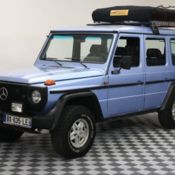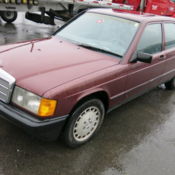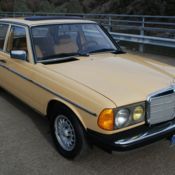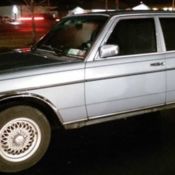Fresh painted awesome looking 177k miles classic Turbo-diesel european car.
| Condition: | Used |
| Make: | Mercedes-Benz |
| Model: | 300-Series |
| SubModel: | Turbo |
| Type: | Sedan |
| Year: | 1983 |
| Mileage: | 177,000 |
| VIN: | WDBAB33A5DB029197 |
| Color: | Gold |
| Fuel: | Diesel |
| Transmission: | Automatic |
| Drive type: | automactic |
| Interior color: | Tan |
| Vehicle Title: | Clear |
| Item location: | Sykesville, Maryland, United States |
| Extras |
|
Air Conditioning, Cruise Control, Power Locks, Power Windows USB player, NEW Speakers, Sunroof, Leather Seats, CD Player |
| Listed by | Private seller |
Description of 1983 Mercedes-Benz 300-Series Turbo |
|
Nice lookin, Fresh-painted, 77k mile, oaccidents,Gold colo, clean title.We receive this car as a trade inn car. car has been detailed and checked by our specialist.Needs: a/c compresso, /c belt, nbsp;tachometer does not wor, rear passenger side window does not work,needalignment.has some rust.If you want to buy it directly please call 4104220300 Albert. History.Mercedes-Benz introduced the W123 four-door executive car in January, 976 to replace the W115. The overall dimensions and wheelbase were lengthened and styling was updated to a less angular more contemporary look. The new look included round head lights with inboard fog lamps in all models except the 280 and 280E which had large rectangular headlights. Later the European models were all changed to the rectangular headlights. North American models retained the round complement. The W115 engines were carried over to the new models, ith the 3 liter 5-cylinder diesel model being renamed from "240D 3.0" to "300D" in the European markets to match North American markets ( in the North American markets the 240 designated the 2.4L 4 cylinder version). The 250 models were given a new 2525 cc inline-six (Type M123, short-stroke version of the 2.8 liter six Type M110) this replaced the 2496 cc Type M114 six. In the spring of 1976, coupe version of the W123 was introduced on a shorter wheelbase than the saloon (2,710 mm (106.7 in) versus 2,795 mm (110.0 in)). This W123C/CE was available as a 230C (later 230CE) and as a 280C/CE in most markets; in North America there was also a 300CD version. The new models proved to be the most popular series to date. Demand for the W123 was so great, ack orders and waiting lists of over a year were common and used cars sold at a premium over the new car list price. A long wheel base chassis (3,425 mm (134.8 in)) was introduced in August, 977. The long chassis versions were available as 7/8 seat saloons through the factory and as a bare chassis with front body clip for ambulances, earse bodies etc. Outside manufactures such as Binz or Miesen produced a variety of models on these long chassis. The long (Lang) versions could be ordered as 240D, 00D and 250 models. The W123T estate (wagon) was introduced at the Frankfurt Auto Show in September, 977. Production of the T models (Transport and Touring) began in March, 978 in the Bremen factory in Germany. Production of the 220D ended in early 1979. The turbo charged 5 cylinder engine was introduced in September 1979 in the 300TD Turbo diesel wagon. The turbocharged 5-cylinder 3 liter diesel engine (Type OM617) was offered with automatic transmission only and limited to the 300TD in most markets. The North American markets were given Turbo models in the 4-door and coupe models as well, ossibly as a response to the competition from higher powered American cars. In June of 1980 a new 2 liter 4-cylinder gasoline engine (Type M102) was introduced to replace the M115. A fuel-injected 2.3 liter version was introduced to replace the carbureted engine in the 230E/TE/CE models. In 1980/81 the carbureted 280 was replaced with the fuel-injected 280E. In September 1982 the rectangular headlights from the 280/280E and power steering were standardized across all European models. In February all European models except the 300TD were offered with an optional 5-speed manual transmission. Production or the W123 ended in January 1986. W123 introduced many innovations in both safety and styling including ABS brakes (optional from August, 980), etractable steering columns and airbags for the driver (optional from 1982). Options: MB-Tex (Mercedes-Benz Texturized Punctured Vinyl) upholstery or velour (European market only) or leather upholstery, nterior wood trim, assenger side exterior mirror (standard on T models), -speed manual transmission (European market only), -speed automatic transmission (standard in turbo diesel models), ower windows with rear-seat switch cut-outs, acuum powered central door locking, ear-facing extra seats (station wagon only), tandheizung (prestart timer controlled engine heating), elf locking differential, un roof, ir conditioning, limate control, Alpine" horn (selectable quieter horn), eadlamp wipers (European market only), empomat (cruise control), ower steering (standard after 1982/08), eat heating, atalytic converter (available from 1984 for California only, rom fall (autumn) 1984 also in Germany for the 230E of which one thousand were built). |
 Home
Home Contact us
Contact us NEWEST CARS
NEWEST CARS SELL YOUR CAR
SELL YOUR CAR FAQ
FAQ






